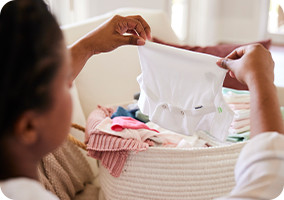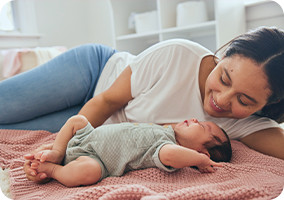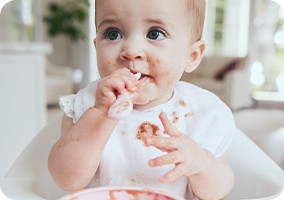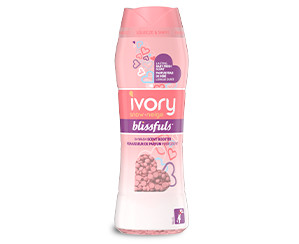How to Wash Newborn Clothes
Here’s your step-by-step guide to washing baby clothes from birth to toddlerhood.
Pre-treat stains
As soon as clothes get stained with something like poop, baby food, or spit-up, strip the dirty garment off your kiddo and rinse off the excess mess. Then, you have a choice. If the stain is small, spritz it with Ivory Snow Laundry Stain Remover and toss it in the laundry bin to await the next load. If it’s more of an all-over thing, you might want to soak it in a tub of water with a half cup or so of Ivory Snow Detergent. Try to wash newborn clothes with stains before they dry as this will help prevent the stain from setting. For more tips, check out our complete guide to stain removal.
Separate and prepare the laundry
Separate baby clothes by color, just as you would adult clothes. If you’re using cloth diapers, they should be a load all their own. Whenever you’re washing newborn clothes, minimize missing-sock syndrome by tossing all baby socks (plus any other small items like bibs or washcloths) into a mesh laundry bag for washing.
Review the care instructions on each garment’s label
… Or don’t? Look, the best way to extend the life of your baby’s clothes is to follow the instructions on the label, but the reality is, if you’ve got a newborn in the house, you have many more important things on your mind than maximizing the usefulness of a onesie your baby will outgrow in three months. We hereby give you permission, when washing newborn clothes, to use whatever water temperature and drying instructions work best for cleaning the majority of your baby clothes and not to worry too hard about the individual labels.
Choose your detergent … and skip other additives
Babies have delicate skin, so whatever detergent you select should be gentle and specially formulated for babies. As the #1 pediatrician recommended brand, Dreft has several choices for you! Ivory Snow Stage 1: Newborn is the perfect hypoallergenic detergent for most newborns, or if you or your baby have sensitivities to dyes or fragrances, Ivory Snow Fragrance Free is a great option. Whatever detergent you choose, avoid adding anything else to your laundry unless you research it thoroughly first.
Wash and dry
Once you’ve gone through the previous steps, this part is probably the simplest! Use cold water, a gentle wash cycle, and a low heat setting in the dryer. (None of this applies to cloth diapers, by the way—they have their own separate washing process.)

How to Wash Baby Clothes for The First Time
Washing baby clothes isn’t just something you’ll do after your kiddo gets them dirty; you also get to wash them when you first buy or receive them. (Lucky you!) This is for a simple reason: Even if baby clothes look pristine when you first receive them, you really don’t know what’s on them until you’ve run them through your own wash with your own chosen variety of Ivory Snow Detergent. This is true whether the clothes are hand-me-downs or brand new. For tips on washing baby clothes for the first time, check out our complete guide to pre-washing baby clothes.
How to Wash Wool Baby Clothes for the First Time
Wool and knit baby clothes provide their own style and their own challenges during washing. Here are some tips to keep wool baby clothes looking great, wash after wash.
Skip the wash sometimes
To preserve wool from wear and tear in the wash, just don’t wash wool baby clothes as frequently as you would those made from other fibers.
Read the label
We know we said earlier that you could ignore the care label, but wool clothes are expensive, so this is the exception. Some wool garments might require hand washing, so don’t just toss them in the hamper with the footie pajamas and onesies.
Choose your detergent
Pick a gentle detergent formulated for your baby’s skin.
Wash and dry—no heat, no hangers!
Always use cold water to wash wool; hot water can shrink the clothes. If your washing machine has a special setting for wool, use it. Unless the care label says tumble drying is OK, don’t put wool baby clothes in the dryer. Don’t hang wool clothes to dry either—the hangers could stretch the clothes out of shape. The best way to dry wool baby clothes is flat—on a laundry rack if possible or on a table if not.
How to Wash Baby Clothes in the Washing Machine
Here are a few tips for getting the most out of machine-washing baby clothes.
Run a gentle cycle with cold water
This is the cycle that’s most likely to be gentle on your baby’s clothes.
Use specialized baby detergent
Such as the #1 pediatrician-recommended baby laundry detergent, Ivory Snow!
Don’t add bleach
Kids’ clothes are often chemically treated to be flame-retardant, and bleach can strip away that protection.
Rinse twice
If you can add an extra rinse to your wash cycle, that’s one more step toward getting your kid’s clothes as fresh and new as possible.
Sanitize the washer
You’ll want to clean the washer and dryer at least once per month using the “tub clean” or “sanitize” cycles.
How to Hand Wash Baby Clothes
Perhaps some of your most delicate or cherished baby clothes need to be washed by hand. Here are some things to consider when hand-washing baby clothes.
Wash your hands
That’s right—to wash by hand, you must first wash your hands. No point in introducing even more dirt and germs to the clothes!
Use lukewarm water
Even if the baby clothes can handle it, water that is too hot will scald your hands. (For extra germ-fighting power, you can soak clothes in hot water for 30 minutes prior to washing.)
Add detergent
While Dreft is a perfect choice for machine-washing baby clothes, it also works well for hand-washing. Ivory Snow is a perfect choice for washing baby clothes—plus, it’s 75% plant-based.
Channel your inner washing machine
When you have clothes, water, and detergent in the washtub, it’s time to agitate, just like the machine would. Swish, swish, swish the clothes around, then let them soak in the soapy water for 30 minutes. Come back, rinse out the clothes, and press them against the side of the sink or tub to wring them dry.
Dry au naturel
Outdoors in the sunlight is the way to go with hand-washed baby clothes. (It’s a pretty great way to dry any clothes, really!)
Why Should You Pre-Wash Your Baby’s Clothes?
Even brand-new clothes aren’t free of germs and dirt—they had to be stored and shipped to the retailer, and shipping containers and warehouses aren’t exactly known for being pristine. In addition—as ridiculous as this sounds—baby clothes are sometimes treated with formaldehyde to keep them looking fresh during shipping. Meanwhile, while hand-me-down baby clothes have often been treated with loving care when they were being used, they might have been in storage for months or even years, collecting dust or possibly even mold. Plenty of germs and allergens can be present on baby clothes when you receive them, no matter what they look like. That’s why it’s so important to pre-wash all new-to-you baby clothes in a gentle pediatrician-recommended detergent (that’s Ivory Snow!).
How to Pre-Wash Baby Clothes?
You might not be one to make a big deal out of doing laundry, but when it comes to washing baby clothes, a little preparedness goes a long way.
Prepare your clothes
First, pull off the price tags and any other packaging from new clothes. Sort the items by colors. Then, secure zippers, buttons, snaps, and other closures. Finally, turn the garments inside out.
Wash and dry
Whatever wash cycle and detergent you plan to use for washing baby clothes, that’s the one you’ll use for pre-washing. (For most people, this will be cold water, gentle cycle, and Ivory Snow Stage 1.)
How Long Before Your Baby Arrives Should You Pre-Wash Clothes?
If this is your first baby, you might be wondering when to start washing baby clothes. As long as you’re not scrambling to pre-wash clothes after the baby arrives because they have nothing to wear, you should be fine. If you’ve been given clothes in a variety of sizes, focus on the smallest ones first—you can always pre-wash the bigger clothes once your child is ready to wear them.
What Should be Pre-Washed Before Your Baby Arrives?
The short answer: Everything that can be washed should be pre-washed. That includes:
Baby clothes
Any baby accessories made of fabric
Blankets and swaddle blankets
Stuffed animals and other cloth toys
Safety Tips for Washing Baby Clothes
Rinse out any solids from stains before washing.
Wash your hands after handling clothes that have been stained with poop or vomit.
Hot water is great for killing germs but bad for scalding your hands! When soaking baby clothes in hot water for pre-treating or disinfecting purposes, take care not to touch the water.
Keep stained clothes wet to keep the stain from setting, but wash within two days to avoid mildew growth.
Washing baby clothes doesn’t have to be all that different from washing your own clothes as long as you have specialized Ivory Snow detergent there to help you take care of the mess. Now, if only you could figure out how to fold baby clothes ...
